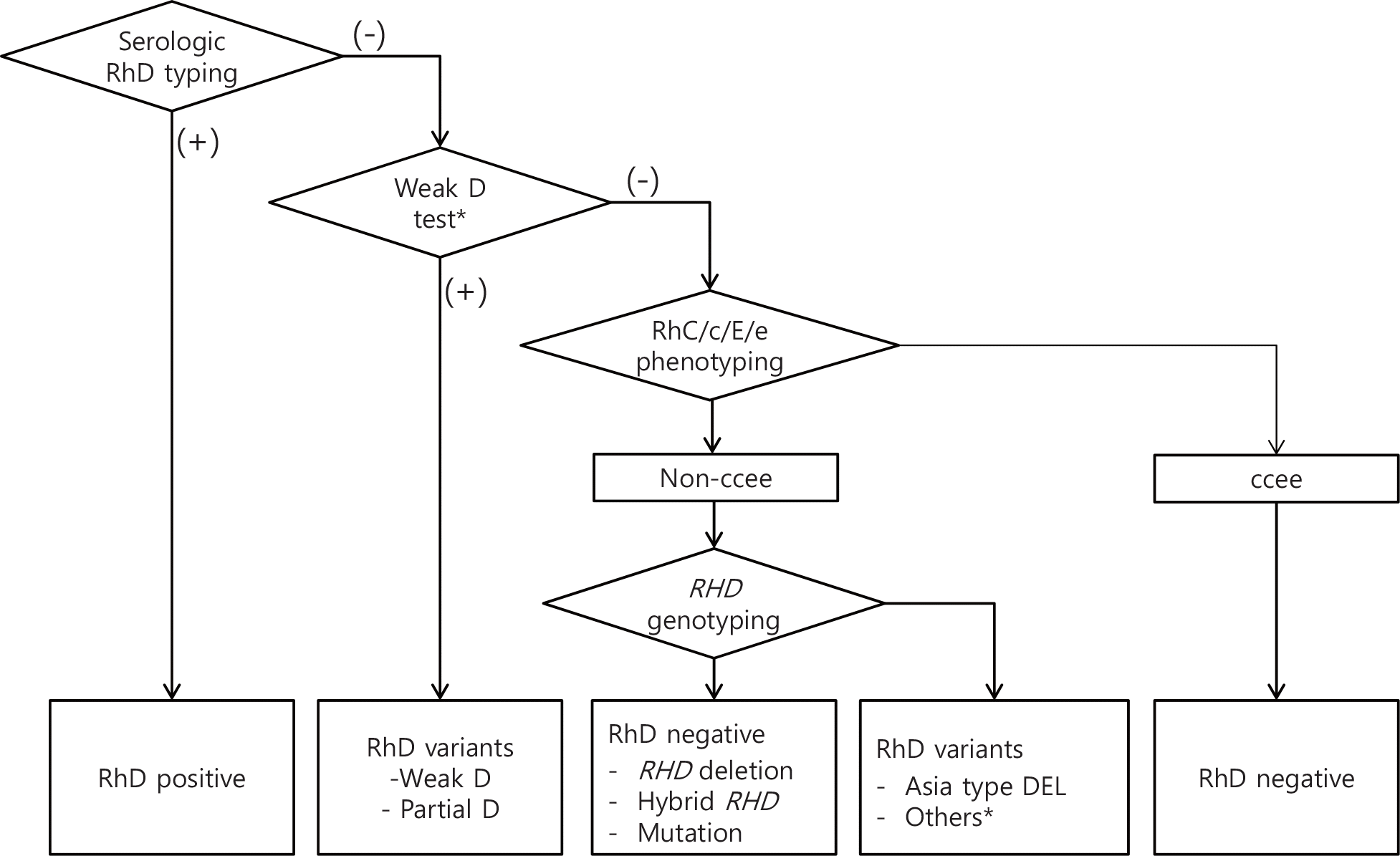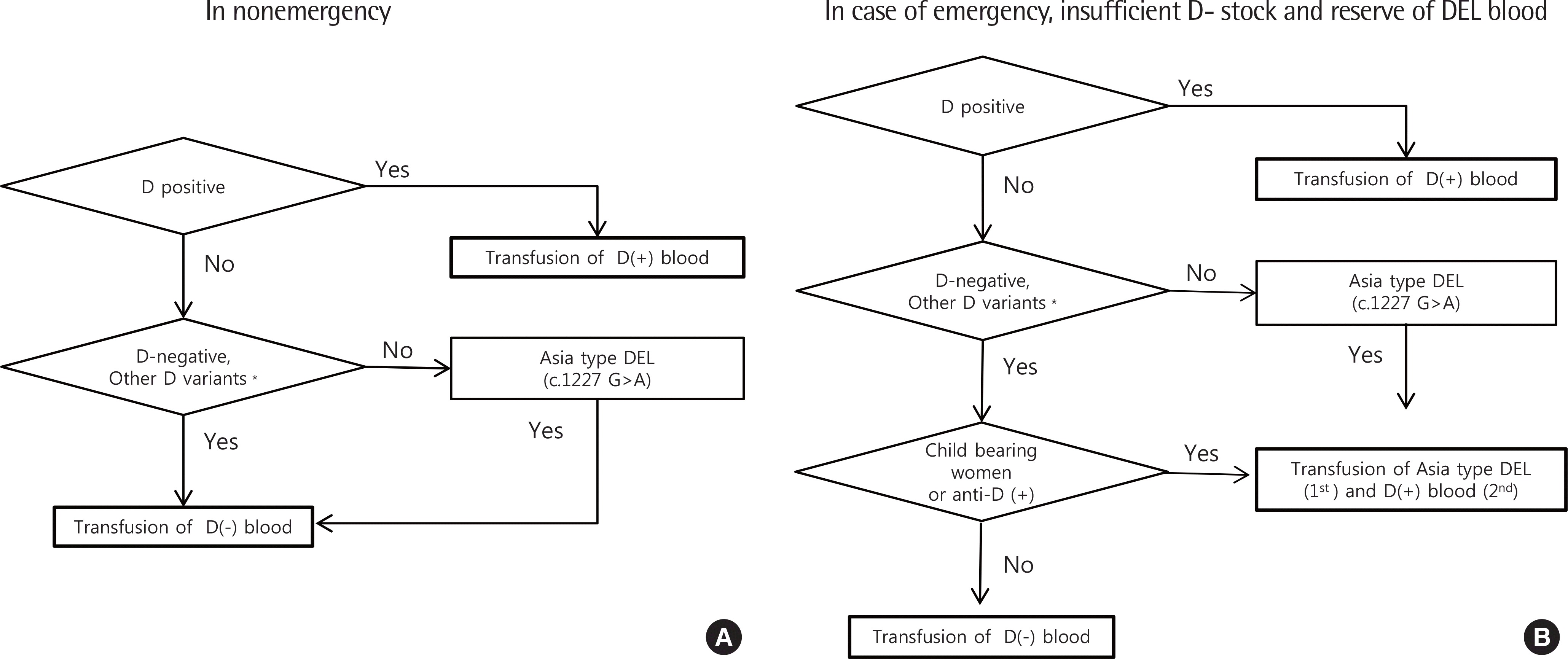Abstract
The prevalence of RhD-negative individuals in the Korean population is approximately 0.15-0.30% and the supply of RhD-negative blood often faces potential shortage. Furthermore, 15-17% of serologically RhD-negative Korean individuals were revealed to be DEL variants and should be treated as RhD-positive when being considered as blood donors. This change is expected to result in a further shortage of RhD-negative blood supply, whereas surplus DEL variant blood stock is created. Therefore, it is now required to amend blood donation and supply policies, and transfusion strategies. In this review, a new transfusion strategy for patients with RhD-negative or variant blood in Korea is discussed, with particular interest in women of child-bearing age, patients with anti-D, and Asia type DEL (c.1227G>A) variants.
Go to : 
REFERENCES
2. Urbaniak SJ, Greiss MA. RhD haemolytic disease of the fetus and the newborn. Blood Rev. 2000; 14:44–61.

3. Fung MK, Grossman BJ, Hillyer CD, Westhoff CM. Technical manual. 18th ed.Bethesda: American Association of Blood Banks;2014.
5. American College of Obstetricians and Gynecologists. Prevention of Rh D alloimmunization. Practice bulletin. 1999; 4.
7. Kim JY, Kim SY, Kim CA, Yon GS, Park SS. Molecular characterization of D– Korean persons: development of a diagnostic strategy. Transfusion. 2005; 45:345–52.

8. Peng CT, Shih MC, Liu TC, Lin IL, Jaung SJ, Chang JG. Molecular basis for the RhD negative phenotype in Chinese. Int J Mol Med. 2003; 11:515–21.

9. Okubo Y, Seno T, Yamano H, Yamaguchi H, Lomas C, Tippett P. Partial D antigens disclosed by a monoclonal anti-D in Japanese blood donors. Transfusion. 1991; 31:782.

10. Kim KH, Kim KE, Woo KS, Han JY, Kim JM, Park KU. Primary anti-D immunization by DEL red blood cells. Korean J Lab Med. 2009; 29:361–5.

11. Shao CP, Wang BY, Ye SH, Zhang WL, Xu H, Zhuang NB, et al. DEL RBC transfusion should be avoided in particular blood recipient in East Asia due to allosensitization and ineffectiveness. J Zhejiang Univ Sci B. 2012; 13:913–8.

12. Yang HS, Lee MY, Park TS, Cho SY, Lee HJ, Lim G, et al. Primary anti-D alloimmunization induced by “Asian type” RHD (c.1227G>A) DEL red cell transfusion. Ann Lab Med. 2015; 35:554–6.
13. Yoon J, Koh YE, Kim HN, Kim J, Jung BK, Lee SA, et al. A Case of primary anti-D alloimmunization by RHD (c. 1227G> A) DEL red blood cell transfusion. Korean J Blood Transfus. 2016; 27:169–73.
14. Contreras M, Knight RC. Controversies in transfusion medicine. Testing for Du: con. Transfusion. 1991; 31:270–2.

15. Daniels G, van der Schoot CE, Olsson ML. Report of the fourth International Workshop on molecular blood group genotyping. Vox Sang. 2011; 101:327–32.

16. Han KS, Park KU, Song EY. Transfusion medicine. 4th ed.Seoul: Medical Book Publisher;2014.
17. Kim KH, Ahn DE, Cho MJ. Nine cases of Du blood group recently detected in Korean Red Cross blood center. Korean J Clin Lab Sci. 1984; 16:136–40.
18. Mak KH, Yan KF, Cheng SS, Yuen MY. Rh phenotypes of Chinese blood donors in Hong Kong, with special reference to weak D antigens. Transfusion. 1993; 33:348–51.

19. Shao CP. Transfusion of RhD-positive blood in “Asia type” DEL recipients. N Engl J Med. 2010; 362:472–3.

20. Singleton BK, Green CA, Avent ND, Martin PG, Smart E, Daka A, et al. The presence of an RHD pseudogene containing a 37 base pair duplication and a nonsense mutation in africans with the Rh D-negative blood group phenotype. Blood. 2000; 95:12–8.

21. Ogasawara K, Suzuki Y, Sasaki K, Osabe T, Isa K, Tsuneyama H, et al. Molecular basis for D- Japanese: identifcation of novel DEL and D- alleles. Vox Sang. 2015; 109:359–65.
22. Dajak S, Krstic JL, Kormoczi G, Dogic V, Burilovic V. Characteristics and frequency of DEL phenotype detected by indirect antiglobulin test in Dalmatia county of Croatia. Transfus Apher Sci. 2014; 50:210–3.

23. Luettringhaus TA, Cho D, Ryang DW, Flegel WA. An easy RHD genotyping strategy for D- East Asian persons applied to Korean blood donors. Transfusion. 2006; 46:2128–37.

24. Seo MH, Won EJ, Hong YJ, Chun S, Kwon JR, Choi YS, et al. An effective diagnostic strategy for accurate detection of RhD variants including Asian DEL type in apparently RhD-negative blood donors in Korea. Vox Sang. 2016; 111:425–30.

25. Seo MH, Kim B, Kwon JR, Choi YS, Kim JN, Park KU, et al. Transfusion strategy and laboratory update on the DEL variant. Korean J Blood Transfus. 2015; 26:1–8.

26. Daniels G. Variants of RhD–current testing and clinical consequences. Br J Haematol. 2013; 161:461–70.
27. Wang D, Lane C, Quillen K. Prevalence of RhD variants, confrmed by molecular genotyping, in a multiethnic prenatal population. Am J Clin Pathol. 2010; 134:438–42.
28. Flegel WA, Wagner FF. Molecular biology of partial D and weak D: implications for blood bank practice. Clin Lab. 2002; 48:53–9.
29. Park JY, Cho D, Choi HW, Jeon MJ, Park MS, Song JW, et al. A patient with RhD (el)(1227G>A) failed to produce detectable anti-D after transfusion of RhD positive red blood cells. Korean J Blood Transfus. 2006; 17:153–8.
30. Gardener GJ, Legler TJ, Hyett JA, Liew YW, Flower RL, Hyland CA. Anti-D in pregnant women with the RHD(IVS3+1G>A)-associated DEL phenotype. Transfusion. 2012; 52:2016–9.
Go to : 
 | Fig. 1.Proposed laboratory algorithm for RhD typing. ∗Weak D test should be performed with at least two different anti-D reagents from several different clones; †Others include weak D, partial D, and non-Asia type DEL |
 | Fig. 2.Algorithm for blood selection depending on RhD types by serology and genotyping in nonemergency under normal circumstances (A) and Transfusion of D(-) blood in case of emergency, insufficient D-stock, and reserve of DEL blood (B). ∗Other D variants include weak D, partial D, and non-Asia type DEL. ∗ Other D variants include weak D, partial D, and non-Asia type DEL. |
Table 1.
Prevalence of RhD- negative/variant blood groups
| European | African | Chinese | Japanese | e Korean | References | |
|---|---|---|---|---|---|---|
| D-negative | 15% | 3-7% | <1% | 0.5% | 0.15% | [1, 16] |
| Weak D | 0.3% | 1.7% | 0.02% | - | 0.01% | [14, 17, 18] |
| DEL∗ | rare | 0% | 30% | 10% | 15-17% | [15, 20, 21] |




 PDF
PDF ePub
ePub Citation
Citation Print
Print


 XML Download
XML Download